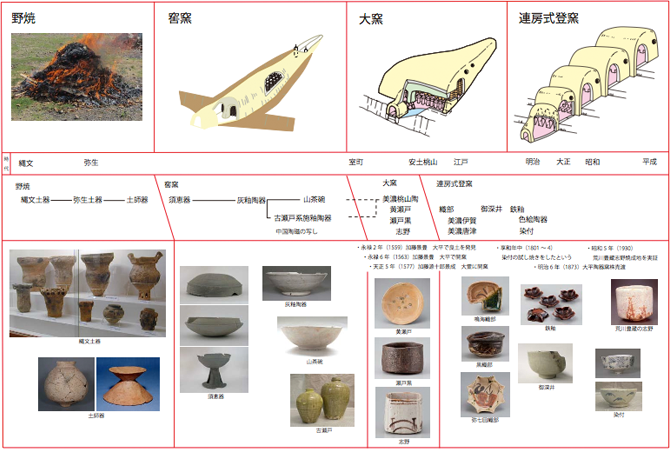美濃の窯
Kilns Used to Fire Mino Ware
Back
美濃の窯
Kilns Used to Fire Mino Ware
Kilns Used to Fire Mino Ware
美濃地方では古くから須恵器生産が行われ、特に可児市内の柿田馬乗洞古窯(消滅)は、東濃地方最古の窯で7世紀初め頃のものと考えられています。
その後、奈良時代から室町時代にかけてもやきものは盛んで、その古窯跡は可児市を含む美濃地方各地に残っています。
醍醐天皇の『延喜式』(905)によれば、美濃は陶器の調貢国のひとつでした。
窯の変遷としては、須恵器、白瓷(しらし:灰釉陶器)、山茶碗などを焼いた地下式や半地下式の窖窯(あながま)が始まりです。その後、安土桃山時代の茶陶「黄瀬戸」、「瀬戸黒」、「志野」を焼いた半地下式の大窯、そして、朝鮮半島から伝わった、大量生産が可能で効率的な連房式登窯が唐津を経て導入され、「織部」が焼成されました。窯の構造や器種の変遷、新たな試みにより生み出された陶器が、美濃桃山陶の文化そのものです。
その後、奈良時代から室町時代にかけてもやきものは盛んで、その古窯跡は可児市を含む美濃地方各地に残っています。
醍醐天皇の『延喜式』(905)によれば、美濃は陶器の調貢国のひとつでした。
窯の変遷としては、須恵器、白瓷(しらし:灰釉陶器)、山茶碗などを焼いた地下式や半地下式の窖窯(あながま)が始まりです。その後、安土桃山時代の茶陶「黄瀬戸」、「瀬戸黒」、「志野」を焼いた半地下式の大窯、そして、朝鮮半島から伝わった、大量生産が可能で効率的な連房式登窯が唐津を経て導入され、「織部」が焼成されました。窯の構造や器種の変遷、新たな試みにより生み出された陶器が、美濃桃山陶の文化そのものです。
Sue ware pots were produced in Mino Province from ancient times and the site of a kiln in the Kakida Umanoribora district of Kani City is believed to be the oldest kiln in the Tōnō area (southeastern Gifu Pref.), dating back to the seventh century.
Later, from the Nara (710-784) to Muromachi periods (1392-1573), pottery production flourished and old kilns have been discovered throughout the Mino district, including the area surrounding Kani City.
According to the “Engishiki” (905), a book listing laws and customs that was compiled on the orders of Emperor Daigo, Mino Province was one of the provinces that paid a tribute in pottery.
Regarding the development of kiln technology, the earliest type, that was used to fire Sue ware, Shirashi (pottery with an ash glaze), Yamajawan bowls, etc., was the buried or partially buried Anagama (single-chamber tunnel kiln). This was followed in the Azuchi-Momoyama period (1573–1603) by the partially buried Ōgama (large single-chamber tunnel kiln) that was used to produce Kiseto, Setoguro and Shino ware utensils for the tea ceremony. Finally, there was the Renbōshiki Noborigama (multi-chambered tunnel kiln) that was introduced from the Korean Peninsula and which facilitated the efficient mass production of ceramics. Initially limited to the Karatsu district of Kyushu, it gradually spread throughout the country and it was this type of kiln that was used to fire Oribe ware. Mino ware from the Momoyama period can be said to embody not only the endeavors of the potters but also developments in kiln design and types of products.
Later, from the Nara (710-784) to Muromachi periods (1392-1573), pottery production flourished and old kilns have been discovered throughout the Mino district, including the area surrounding Kani City.
According to the “Engishiki” (905), a book listing laws and customs that was compiled on the orders of Emperor Daigo, Mino Province was one of the provinces that paid a tribute in pottery.
Regarding the development of kiln technology, the earliest type, that was used to fire Sue ware, Shirashi (pottery with an ash glaze), Yamajawan bowls, etc., was the buried or partially buried Anagama (single-chamber tunnel kiln). This was followed in the Azuchi-Momoyama period (1573–1603) by the partially buried Ōgama (large single-chamber tunnel kiln) that was used to produce Kiseto, Setoguro and Shino ware utensils for the tea ceremony. Finally, there was the Renbōshiki Noborigama (multi-chambered tunnel kiln) that was introduced from the Korean Peninsula and which facilitated the efficient mass production of ceramics. Initially limited to the Karatsu district of Kyushu, it gradually spread throughout the country and it was this type of kiln that was used to fire Oribe ware. Mino ware from the Momoyama period can be said to embody not only the endeavors of the potters but also developments in kiln design and types of products.
拡大図(PDF)
Enlarged view(PDF)
